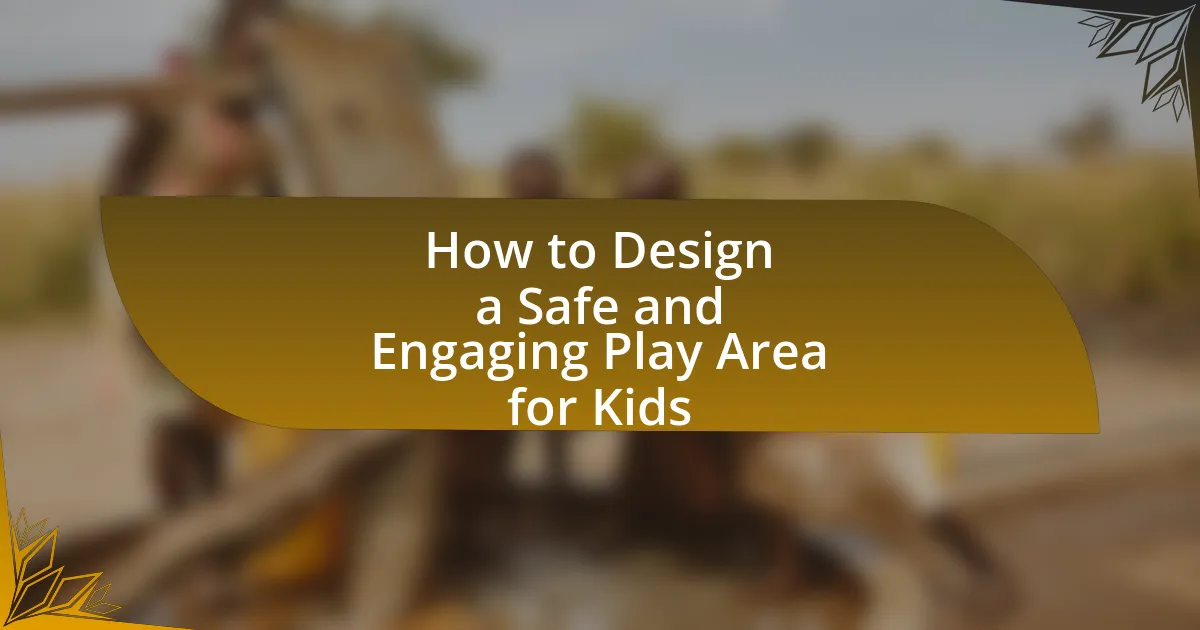The article focuses on the essential considerations for designing a safe and engaging play area for children. Key aspects include the implementation of safety features, age-appropriate equipment, accessibility, and stimulating environments that promote physical and cognitive development. It discusses the impact of safety regulations, essential standards, and the influence of materials on safety. Additionally, the article highlights the importance of layout, zoning, and community involvement in creating effective play spaces. Best practices for maintenance and the incorporation of natural elements are also examined to ensure ongoing safety and engagement in play areas.

What are the key considerations for designing a safe and engaging play area for kids?
Key considerations for designing a safe and engaging play area for kids include safety features, age-appropriate equipment, accessibility, and stimulating environments. Safety features such as soft ground surfaces, secure fencing, and proper spacing between equipment minimize injury risks. Age-appropriate equipment ensures that children can safely use the structures, with guidelines from organizations like the Consumer Product Safety Commission recommending specific designs for different age groups. Accessibility is crucial, allowing children of all abilities to participate, which can be achieved through inclusive design principles. Finally, stimulating environments that incorporate natural elements, varied textures, and interactive features promote creativity and physical activity, aligning with studies that show active play contributes to children’s physical and cognitive development.
How do safety regulations impact play area design?
Safety regulations significantly impact play area design by establishing standards that ensure the safety of children during play. These regulations dictate the materials used, the layout of equipment, and the overall design to minimize hazards. For instance, the Consumer Product Safety Commission (CPSC) provides guidelines that recommend specific fall heights and protective surfacing to reduce injury risks. Compliance with these regulations not only enhances safety but also influences the choice of equipment and the spatial arrangement within the play area, ensuring that it meets both safety and developmental needs of children.
What are the essential safety standards to follow?
The essential safety standards to follow when designing a safe and engaging play area for kids include compliance with the ASTM F1487 standard for playground equipment, adherence to the CPSC guidelines for playground safety, and ensuring that materials used are non-toxic and age-appropriate. These standards are established to minimize risks of injury and ensure a safe environment for children. For instance, the ASTM F1487 standard outlines specifications for equipment design, installation, and maintenance, while the CPSC guidelines provide recommendations for surfacing materials and layout to reduce fall hazards.
How can materials influence safety in play areas?
Materials significantly influence safety in play areas by determining the risk of injury during play. For instance, soft materials like rubber or foam can cushion falls, reducing the likelihood of serious injuries, while hard surfaces like concrete can increase the risk of harm. According to the U.S. Consumer Product Safety Commission, using impact-absorbing materials can lower the risk of head injuries by up to 80% in playgrounds. Additionally, non-toxic and durable materials ensure that play structures withstand wear and tear, maintaining safety over time. Thus, the choice of materials directly impacts the overall safety and well-being of children in play areas.
What elements contribute to an engaging play area?
An engaging play area includes diverse play equipment, safe surfaces, natural elements, and interactive features. Diverse play equipment, such as swings, slides, and climbing structures, caters to various interests and developmental stages, promoting physical activity and social interaction. Safe surfaces, like rubber mats or grass, reduce injury risks, ensuring children can explore freely. Incorporating natural elements, such as trees and gardens, enhances sensory experiences and encourages imaginative play. Interactive features, such as musical instruments or water play areas, stimulate creativity and engagement, making the play area more appealing. Research indicates that play environments with these elements significantly enhance children’s physical, social, and cognitive development.
How do different types of play equipment enhance engagement?
Different types of play equipment enhance engagement by providing varied sensory experiences and physical challenges that cater to diverse interests and developmental stages. For instance, climbing structures promote physical activity and risk-taking, which can lead to increased confidence and social interaction among children. Additionally, interactive equipment like swings and slides encourages cooperative play, fostering communication and teamwork skills. Research indicates that children are more likely to engage in play when equipment is designed to be visually stimulating and physically challenging, as seen in studies conducted by the American Academy of Pediatrics, which highlight the importance of active play in child development.
What role does natural play have in children’s engagement?
Natural play significantly enhances children’s engagement by fostering creativity, problem-solving skills, and physical activity. Engaging with natural elements, such as trees, rocks, and water, encourages children to explore their environment, which stimulates their imagination and promotes active learning. Research indicates that children who participate in natural play exhibit increased attention spans and improved social interactions, as they collaborate and negotiate during play. A study published in the journal “Children, Youth and Environments” found that children who play in natural settings demonstrate higher levels of engagement and satisfaction compared to those in traditional playgrounds. This evidence underscores the importance of incorporating natural play into play area designs to optimize children’s engagement and developmental outcomes.
Why is the layout important in play area design?
The layout is crucial in play area design because it directly influences children’s safety, engagement, and social interaction. A well-planned layout minimizes hazards by ensuring adequate spacing between equipment and clear sightlines for supervision, which reduces the risk of accidents. Additionally, an effective layout promotes active play and exploration by strategically placing equipment to encourage movement and interaction among children. Research indicates that play areas designed with thoughtful layouts can enhance children’s physical activity levels and social skills, as evidenced by studies showing increased playtime and interaction in environments that prioritize layout design.
How can zoning improve safety and engagement?
Zoning can improve safety and engagement by clearly defining areas for different activities, which helps to minimize conflicts and accidents. For instance, separating active play zones from quieter areas reduces the risk of injuries among children engaged in various activities. Research indicates that well-defined zones can enhance children’s focus and participation, as they understand the purpose of each area, leading to increased engagement. A study by the National Recreation and Park Association found that organized play spaces with designated zones resulted in a 30% increase in children’s active participation compared to unstructured environments.
What are the best practices for creating accessible pathways?
The best practices for creating accessible pathways include ensuring a minimum width of 36 inches to accommodate mobility devices, using non-slip surfaces to prevent falls, and maintaining a consistent slope of no more than 1:12 for ramps. These guidelines are supported by the Americans with Disabilities Act (ADA), which mandates accessibility standards for public spaces. Additionally, pathways should be free of obstacles and clearly marked to enhance navigation for all users, including children with disabilities.
How can community input shape the design of play areas?
Community input can significantly shape the design of play areas by ensuring that the needs and preferences of local families are reflected in the final layout and features. Engaging community members through surveys, focus groups, and public meetings allows designers to gather valuable insights about desired equipment, safety concerns, and accessibility features. For instance, a study by the American Planning Association found that community involvement in park design leads to higher usage rates and satisfaction among residents, demonstrating the effectiveness of incorporating local feedback into planning processes.
What are the benefits of involving children in the design process?
Involving children in the design process enhances creativity, ensures the design meets their needs, and fosters a sense of ownership. Children provide unique perspectives that can lead to innovative solutions, as their ideas often reflect their experiences and preferences. Research indicates that when children participate in design, such as in play area development, the resulting spaces are more engaging and enjoyable for them, leading to increased usage and satisfaction. For instance, a study by the University of Edinburgh found that child-involved design processes resulted in play areas that better catered to children’s developmental needs and preferences, ultimately promoting healthier play experiences.

What specific features should be included in a play area for kids?
A play area for kids should include safety surfacing, age-appropriate equipment, and interactive elements. Safety surfacing, such as rubber mats or soft grass, reduces the risk of injury from falls. Age-appropriate equipment ensures that children can safely engage with the structures, promoting physical development and reducing accidents. Interactive elements, like climbing walls or sensory panels, encourage exploration and social interaction, enhancing cognitive and social skills. These features collectively create a safe and engaging environment that supports children’s physical, emotional, and social development.
What types of play equipment are essential for a well-rounded play area?
Essential types of play equipment for a well-rounded play area include swings, slides, climbing structures, and interactive play panels. Swings promote physical activity and coordination, while slides provide excitement and encourage risk-taking in a safe environment. Climbing structures enhance strength and problem-solving skills, and interactive play panels stimulate cognitive development through imaginative play. Research indicates that diverse play equipment supports various developmental milestones, fostering social, emotional, and physical growth in children.
How do climbing structures benefit children’s physical development?
Climbing structures significantly enhance children’s physical development by promoting strength, coordination, and balance. Engaging in climbing activities requires children to use various muscle groups, which builds overall physical strength. Research indicates that climbing helps improve gross motor skills, as children navigate different heights and surfaces, enhancing their coordination and spatial awareness. A study published in the Journal of Physical Activity and Health found that children who regularly engage in climbing activities show improved balance and agility, which are crucial for their overall physical development.
What are the advantages of incorporating sensory play elements?
Incorporating sensory play elements enhances children’s cognitive, social, and emotional development. Sensory play stimulates the brain’s neural pathways, promoting problem-solving skills and creativity. Research indicates that sensory experiences can improve fine motor skills and hand-eye coordination, as children manipulate various textures and materials. Additionally, sensory play fosters social interaction, as children often engage in cooperative play, sharing and communicating with peers. A study published in the Journal of Occupational Therapy for Children and Youth found that sensory play significantly benefits children with sensory processing issues, helping them to better integrate sensory information.
How can landscaping enhance the play area experience?
Landscaping can enhance the play area experience by creating a visually appealing and stimulating environment that encourages exploration and play. Thoughtfully designed landscapes incorporate natural elements such as trees, shrubs, and flowers, which provide shade, promote biodiversity, and create a sense of adventure. Research indicates that children are more likely to engage in physical activity and imaginative play in well-landscaped areas, as these environments can stimulate creativity and social interaction. For instance, a study published in the “Journal of Environmental Psychology” found that children in green play spaces exhibited higher levels of physical activity and social behavior compared to those in barren areas. Thus, effective landscaping not only beautifies the play area but also significantly contributes to children’s overall play experience and development.
What types of plants are safe and beneficial for play areas?
Safe and beneficial plants for play areas include non-toxic varieties such as sunflowers, marigolds, and lavender. These plants are safe for children as they do not pose any poisoning risk and can enhance the play environment by attracting beneficial insects like pollinators. Additionally, plants like clover and grass provide soft surfaces for play, reducing the risk of injury. Research indicates that incorporating greenery in play areas can improve children’s mood and encourage outdoor activity, making these plants not only safe but also beneficial for overall child development.
How can shade structures improve play area usability?
Shade structures enhance play area usability by providing protection from sun exposure and inclement weather, which encourages longer and more frequent use. Research indicates that shaded areas can reduce surface temperatures by up to 20 degrees Fahrenheit, making play environments more comfortable for children. Additionally, shade structures help prevent heat-related illnesses, allowing children to engage in outdoor activities safely. By creating a more inviting and safe environment, shade structures significantly increase the overall usability of play areas.
What safety features should be integrated into play equipment?
Safety features that should be integrated into play equipment include impact-absorbing surfaces, rounded edges, and secure anchoring systems. Impact-absorbing surfaces, such as rubber mats or engineered wood fiber, reduce the risk of injury from falls, as studies show that proper surfacing can decrease fall-related injuries by up to 80%. Rounded edges on equipment prevent cuts and bruises, while secure anchoring systems ensure stability and prevent tipping, which is crucial for maintaining safety during play. These features collectively enhance the safety of play areas, making them suitable for children.
How can soft surfacing reduce injury risks?
Soft surfacing can significantly reduce injury risks by providing a cushioned layer that absorbs impact during falls. This cushioning effect minimizes the force exerted on a child’s body, thereby decreasing the likelihood of injuries such as fractures or concussions. Research indicates that surfaces like rubber mats or engineered wood fiber can lower fall-related injuries by up to 50% compared to harder surfaces like concrete or asphalt. The National Program for Playground Safety emphasizes that proper soft surfacing is essential for safe play environments, highlighting its role in injury prevention.
What are the best practices for maintaining play equipment safety?
The best practices for maintaining play equipment safety include regular inspections, proper installation, and timely repairs. Regular inspections should occur at least monthly to identify wear and tear, loose parts, or hazards. Proper installation according to manufacturer guidelines ensures stability and safety. Timely repairs of any damaged components prevent accidents and maintain the equipment’s integrity. According to the U.S. Consumer Product Safety Commission, over 200,000 children are treated for playground-related injuries annually, highlighting the importance of these maintenance practices in reducing risks.

How can ongoing maintenance and community involvement ensure the play area remains safe and engaging?
Ongoing maintenance and community involvement ensure the play area remains safe and engaging by regularly addressing safety concerns and fostering a sense of ownership among local residents. Regular inspections and repairs of equipment, surfaces, and landscaping help identify hazards such as broken structures or unsafe surfaces, which can lead to injuries if not addressed. For instance, a study by the American Academy of Pediatrics emphasizes that well-maintained play areas significantly reduce the risk of accidents. Community involvement, through volunteer clean-up days or feedback sessions, encourages residents to participate in the upkeep and improvement of the space, ensuring it meets the needs and preferences of children and families. This collaborative effort not only enhances safety but also promotes a vibrant, engaging environment that encourages play and social interaction.
What maintenance practices are essential for play area safety?
Regular inspections, prompt repairs, and proper surfacing are essential maintenance practices for play area safety. Conducting weekly inspections helps identify hazards such as broken equipment or unsafe surfaces, ensuring timely repairs are made to prevent accidents. Additionally, maintaining appropriate surfacing materials, such as mulch or rubber mats, is crucial for cushioning falls and reducing injury risk. According to the U.S. Consumer Product Safety Commission, proper maintenance can significantly lower the likelihood of injuries in playgrounds, emphasizing the importance of these practices in safeguarding children.
How often should inspections be conducted?
Inspections should be conducted at least once a month for play areas to ensure safety and compliance with standards. Regular monthly inspections help identify potential hazards, wear and tear, and maintenance needs, which are crucial for maintaining a safe environment for children. According to the U.S. Consumer Product Safety Commission, frequent inspections can significantly reduce the risk of accidents and injuries in playgrounds.
What common issues should be monitored regularly?
Common issues that should be monitored regularly in a play area for kids include equipment safety, surface conditions, and cleanliness. Equipment safety involves checking for wear and tear, ensuring that all components are secure and free from sharp edges or protrusions. Surface conditions refer to the maintenance of the ground material, such as ensuring that rubber mats or grass are intact and free from hazards like holes or debris. Cleanliness is crucial to prevent the spread of germs and ensure a safe environment; this includes regular inspections for litter, animal waste, and any potential allergens. Regular monitoring of these issues helps maintain a safe and engaging play area, reducing the risk of injuries and promoting a healthy play environment.
How can community programs support the play area’s success?
Community programs can support the play area’s success by fostering engagement, providing resources, and facilitating maintenance. Engaged community programs can organize events that promote the play area, increasing usage and community involvement. Additionally, these programs can secure funding or donations for equipment and improvements, ensuring the play area remains safe and appealing. Regular maintenance and safety checks, often coordinated through community initiatives, help sustain the play area’s condition, thereby enhancing its long-term success.
What role do volunteers play in maintaining play areas?
Volunteers play a crucial role in maintaining play areas by providing essential labor and resources for upkeep and improvement. They engage in activities such as cleaning, repairing equipment, and landscaping, which directly contribute to the safety and aesthetic appeal of these spaces. For instance, a study by the National Recreation and Park Association found that community volunteer efforts can significantly enhance the quality of local parks and play areas, leading to increased usage and community satisfaction.
How can local events promote engagement with the play area?
Local events can promote engagement with the play area by creating community involvement and fostering social interactions among families. These events, such as festivals, workshops, or playdates, encourage parents and children to visit the play area together, increasing foot traffic and usage. Research indicates that community events can enhance social cohesion, which in turn leads to more frequent visits to local amenities, including play areas. For example, a study by the National Recreation and Park Association found that communities with regular events saw a 30% increase in park usage, demonstrating the direct correlation between local events and engagement with recreational spaces.
What are some best practices for designing a safe and engaging play area for kids?
To design a safe and engaging play area for kids, prioritize safety features such as soft ground materials, age-appropriate equipment, and clear visibility for supervision. Research indicates that using impact-absorbing surfaces like rubber mulch or foam can reduce injury risks by up to 50%. Additionally, incorporating diverse play structures encourages physical activity and cognitive development, as studies show that varied play experiences enhance children’s social skills and creativity. Regular maintenance and inspections of equipment further ensure safety, with the Consumer Product Safety Commission recommending routine checks to prevent accidents.
